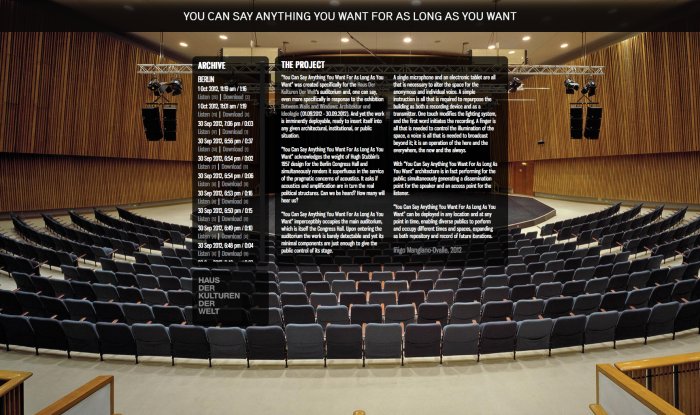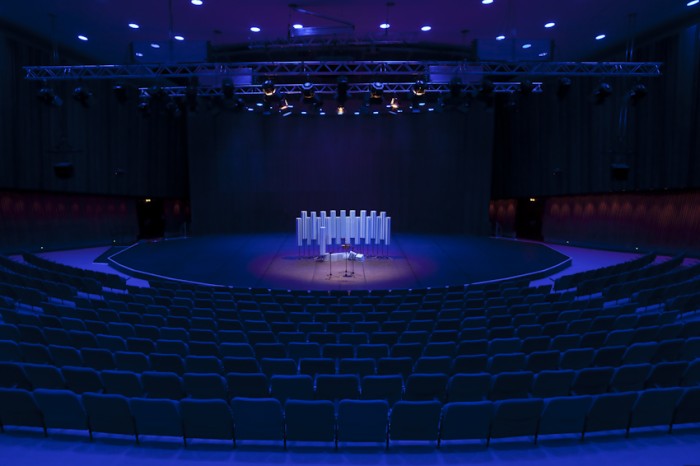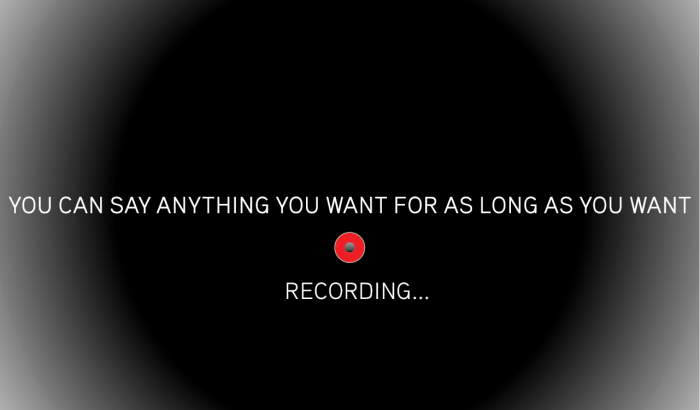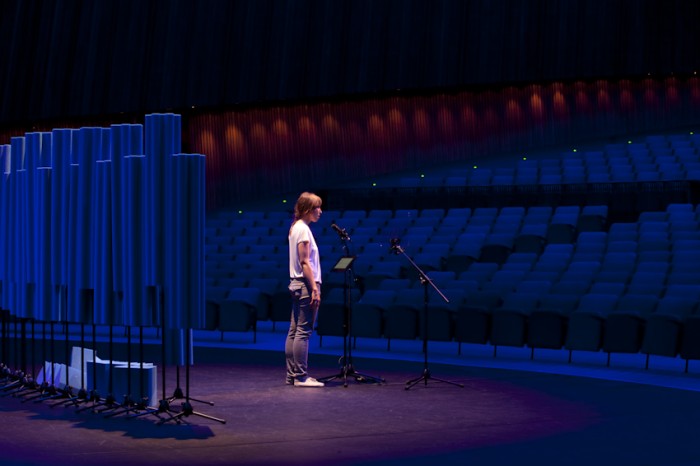Wireless Voice Recording Interface for a Tablet Computer; Custom Software to record and detect voice; DMX light control for auditorium lights; instantaneous voice recording upload to public online archive.
The architect Hugh A. Stubbins saw his Kongresshalle, with the auditorium as its centerpiece, as the embodiment of freedom of speech and opinion. The theme of Manglano-Ovalle’s installation is the influence of acoustic and spatial staging on the power of the spoken word. On the stage in the middle of the empty auditorium stands a microphone, accessible to all visitors. However, instead of amplifying, it absorbs speech and sends it unedited to an Internet archive which collects the plurality of voices to be publicly heard all over the world.
From the online archive:
“You Can Say Anything You Want For As Long As You Want was created specifically for the Haus Der Kulturen Der Welt‘s auditorium and, one can say, even more specifically in response to the exhibition Between Walls and Windows: Architektur und Ideologie (01.09.2012 – 30.09.2012). And yet the work is imminently deployable, ready to insert itself into any given architectural, institutional, or public situation.
You Can Say Anything You Want For As Long As You Want acknowledges the weight of Hugh Stubbin’s 1957 design for the Berlin Congress Hall and simultaneously renders it superfluous in the service of the pragmatic concerns of acoustics. It asks if acoustics and amplification are in turn the real political structures. Can we be heard? How many will hear us?
You Can Say Anything You Want For As Long As You Want imperceptibly occupies the main auditorium, which is itself the Congress Hall. Upon entering the auditorium the work is barely detectable and yet its minimal components are just enough to give the public control of its stage.
A single microphone and an electronic tablet are all that is necessary to alter the space for the anonymous and individual voice. A simple instruction is all that is required to repurpose the building as both a recording device and as a transmitter. One touch modifies the lighting system, and the first word initiates the recording. A finger is all that is needed to control the illumination of the space, a voice is all that is needed to broadcast beyond it; it is an operation of the here and the everywhere, the now and the always.
With You Can Say Anything You Want For As Long As You Want architecture is in fact performing for the public; simultaneously generating a dissemination point for the speaker and an access point for the listener.
You Can Say Anything You Want For As Long As You Want can be deployed in any location and at any point in time, enabling diverse publics to perform and occupy different times and spaces, expanding as both repository and record of future iterations.”
Iñigo Manglano-Ovalle, 2012
Iñigo Manglano-Ovalle (*1961 in Spain) is internationally recognized for his activist-inspired public art and studio-based works. He received numerous awards including a Guggenheim Fellowship (2009) and a MacArthur Foundation Fellowship (2001). Recently he has presented major projects at The Power Plant, Toronto (2011), Kunstwerke, Berlin (2011), The Art Institute of Chicago (2011), Massachusetts Museum of Contemporary Art (2009), Documenta XII, Kassel (2007). He is professor of Art Theory & Practice at Northwestern University, Chicago.
Inigo Manglano-Ovalle: You Can Say Anything You Want For As Long As You Want
-
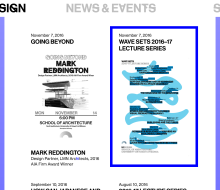
School of Architecture University of Hawaiʻi at Mānoa

-

Daniel Sauter: Light Spa

-
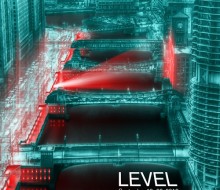
Skip Message

-

The Bluest Eye

-

Book: Rapid Android Development: Build Rich, Sensor-Based Applications with Processing

-

Ketai Library for Processing Android

-
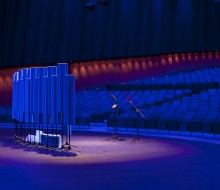
Inigo Manglano-Ovalle: You Can Say Anything You Want For As Long As You Want

-

UNStudio Burnham Pavilion Lighing Program


